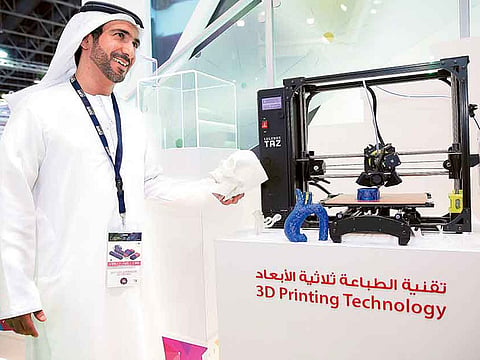3D printing adds a new dimension to UAE healthcare
While 3D systems have already made a mark on a range of industries, exciting advances have seen the tech being applied in complex medical procedures such as tumour removals

The next time someone flashes that perfect smile, look closer — they might be sporting 3D-printed ceramic teeth. One of the most exciting technologies around is 3D printing, and it is making deep inroads in not only consumer electronics but also healthcare. And you will get to see it in action at the 3D Medical Printing Zone, at the Arab Health expo. The zone will also showcase models of various body parts, bionic limbs, live 3D printing and a conference with the theme of Fast Forward 2030.
Dr Thomas Bartel, Section Head, Invasive Cardiology, Heart & Vascular Institute, Cleveland Clinic Abu Dhabi, says 3D printing has brought a new level of personalised patient care to the healthcare sector in the UAE. Moreover, the technology minimises risks and maximises positive outcomes. He explains the advantages can be grouped into three categories: procedural planning, quality assurance, and an advanced education. The first involves using 3D organ replicas to give clear sight of any target region and what to expect in the operating room. “3D models can also be used as a basis for QA to identify the cause of any adverse outcomes following a procedure. Lastly, we can use them in the operating rooms as visual aid to guide and educate trainees.”
Cleveland Clinic Abu Dhabi has been using 3D printing for surgery and catheter-based interventional procedures since February 2016, including for challenging cases such as valve and device implants and surgery for congenital heart diseases. Dr Bartel points out that last year more than a fifth of deaths in the UAE were caused by heart disease, and this technology can ensure patients receive high-quality care.
Dubai Health Authority (DHA) would agree. In December, doctors at Dubai Hospital performed a kidney surgery assisted by 3D printing tech — DHA claims this was a first in the region. Dr Yaser Al Saeedi, the main surgeon, says medical imaging was inadequate in this case, and a 3D-printed model played a crucial role in facilitating the safe removal of a tumour. It also sped up the surgery — instead of the usual five hours, this one took only three.
In fact, Humaid Al Qatami, Chairman of the Board and Director-General of DHA, believes using 3D technology for surgeries and other medical purposes “is the future”, and states that DHA is currently working on developing regulations for 3D printing in the medical sector in Dubai.
And yes, dentists in Dubai will be able to bring back the toothy grin with 3D-printed teeth. Dr Mohammad Al Redha, Director of Transformational Office at DHA, says 3D printing ticks all the boxes by delivering absolute precision during surgeries, reducing the time taken for procedures and being cost-effective. For instance, replacing a tooth usually takes up to two weeks. In contrast, printing a ceramic version takes just 20 minutes. “We simply take the impression, run it through a software design and place a ceramic cube in the machine. The machine then does its job and carves the tooth to exact precision.” He adds that similar tech will also be used to print plastic 3D casts that are stronger and more comfortable for patients.
Looking ahead, Dr Al Redha believes the sky’s the limit for 3D printing, given the vast amount of ongoing global research, especially for printing body parts made from stem cells. Dr Bartel, too, anticipates 3D printing tech will grow from use in special cases, and will be deployed for all kinds of specialised tasks in cardiovascular medicine and surgical disciplines — for example, to create custom tissue implants for specific patients.
“Although this field, [called] bioprinting for biomedical applications, is still far from clinical applicability, it can become a truly revolutionary progress in the medical field by removing the waiting periods for implants and even human transplants.”
Sign up for the Daily Briefing
Get the latest news and updates straight to your inbox


